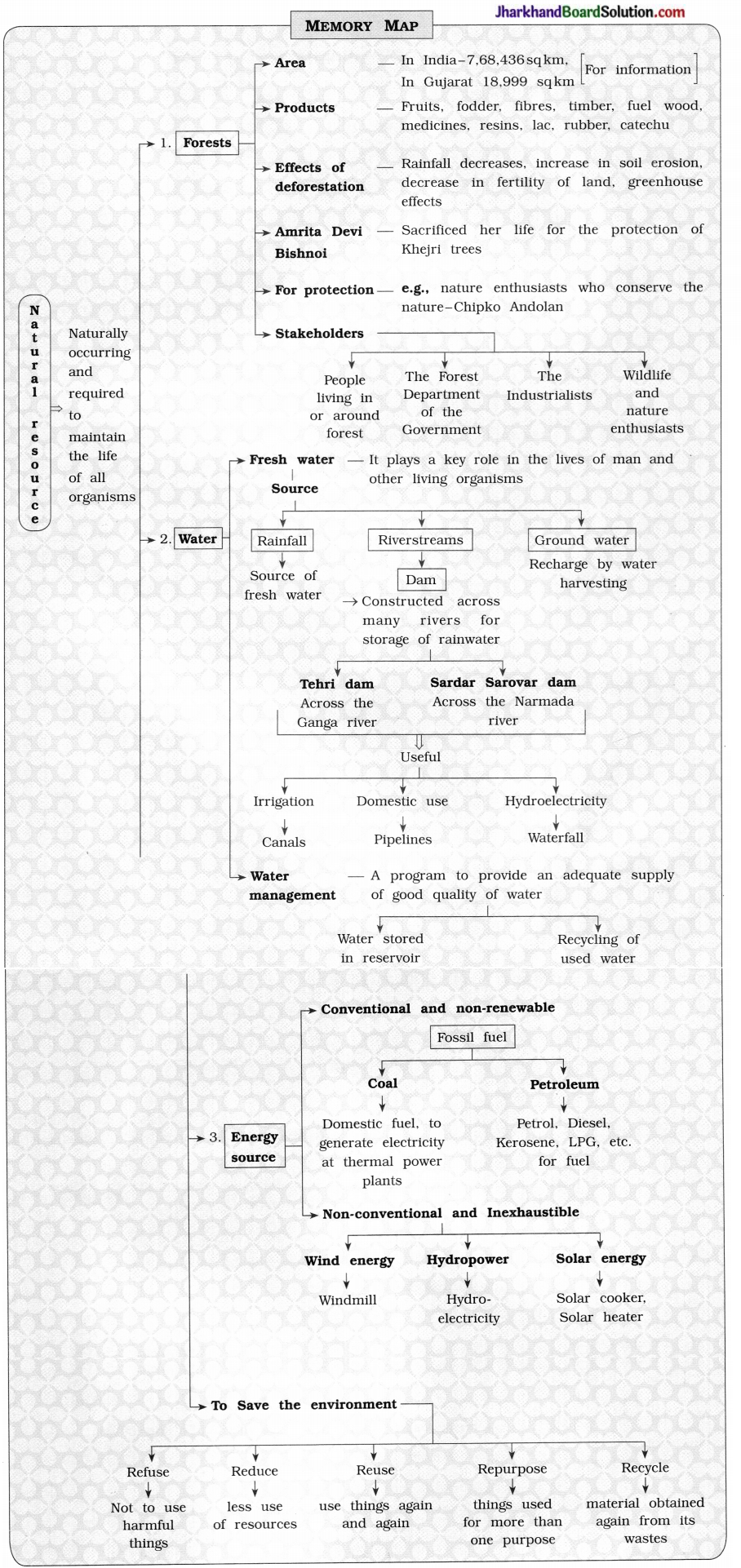Jharkhand Board JAC Class 10 Science Important Questions Chapter 16 Management of Natural Resources Important Questions and Answers.
JAC Board Class 10 Science Important Questions Chapter 16 Management of Natural Resources
Additional Questions and Answers
Question 1.
Distinguish between:
(1) Recycle and Reuse
Answer:
| Recycle | Reuse |
| 1. Recycle is a process of producing new materials from industrial and domestic wastes. | 1. Reuse is using materials or its pieces again for some other purpose. |
| 2. In the process of recycling, some energy is utilized. | 2. In reuse energy is not utilized. |
| 3. Example: Plastic, paper glass, metal piece, etc. can be melted at appropriate temperature and new materials can be produced. | 3. Example: Cups and plates made of China clay, ceramic tiles can be used to make decorative wall pieces. |
(2) Coal and Petroleum
Answer:
| Coal | Petroleum |
| 1. It is carbon based fuel source. | 1. It is hydrocarbon based fuel source. |
| 2. It is solid form of fossil fuel. | 2. It is liquid form of fossil fuel. |
| 3. Its energy can be converted into electricity and steam. | 3. It is used in forms of petrol, diesel, kerosene, fuel oil, etc. |
| 4. It is used as a fuel as such in homes and in industry or at thermal power plants to generate electricity. | 4. It is mainly used in automobile vehicles. |
Question 2.
Give scientific reasons for the following statements :
(1) Few simple steps should be helpful to conserve energy resources.
Answer:
- Switch off the lights, fans, television and other electrical appliances when not in use.
- Make use of stairs instead of lift at least up to two to three floors in a building.
- Pressure cookers should be used to save the fuels.
- Bicycles can be used to cover short distances.
- Public transport system (local buses and trains) in the cities should be made available so people do not use their own vehicles to commute.
By such simple steps, we can save electricity and fossil fuels.
(2) We should use fossil fuels rationally and judiciously.
Answer:
We should use coal and petroleum judiciously because:
- Coal and petroleum are fossil fuels which are exhaustible and non-renewable resource.
- Reserves of coal and petroleum are limited.
- It takes millions of years for nature to replenish these resources.
- Burning of fossil fuels pollutes the atmosphere by forming oxides of carbon, nitrogen and sulphur, which accumulate in atmosphere.
- Carbon dioxide is a greenhouse gas which leads to global warming.
(3) We should adopt water harvesting.
Answer:
Advantages of water harvesting are :
- It provides water for recharging underground water reservoir.
- It provides water for potable use.
- It provides water for irrigation.
- It provides water for vegetation to grow.
![]()
(4) Dams are useful to the society in the various ways.
Answer:
Advantages of dams:
- Storage of adequate water ensure the water supply to crop field round the year for irrigation.
- The water from dams is used to generate electricity.
- To stop the flow of rain water to sea and help to control flood to some extent.
- Canal systems leading from the dams can transfer large amounts of water over great distance i.e., to semi-arid and arid regions.
(5) Watershed management has its own importance.
Answer:
The advantages of watershed management:
- It emphasises scientific conservation of soil and water in order to increase biomass production.
- The main objective is to develop primary resources of land and water.
- To produce secondary resources of plants and animals for use in a manner, which will not cause ecological imbalance.
Question 3.
Carefully observe the given s diagram / chart and answer the questions related with it:
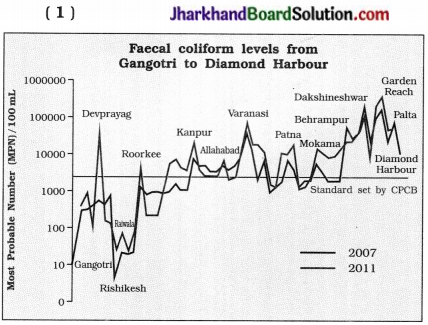
Questions:
- State the name of microbe that has increased beyond a safe level in the river Ganga.
- What is the main cause of the s contamination of the river Ganga?
- From which source does we know that S the pollution level in the Ganga is high?
Answer:
- Faecal coliform are the microbial s pollutants that has increased in the river Ganga beyond safe level.
- Largely untreated sewage is dumped into the river Ganga which is the main cause for contamination.
- CPCB – Central Pollution Control Board
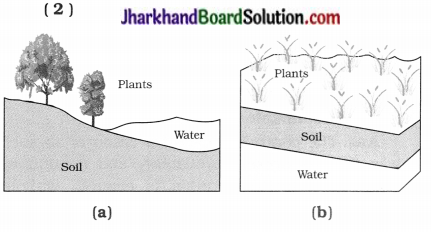
Questions:
- Locate and name the water reservoirs in diagram (a) and (b).
- What is the advantage of one over the other and why?
Answer:
- (a) a pond as water reservoir (b) Ground water body
- Ground water is more advantageous than pond water because it does not evaporate does not easily contaminate by pollutants and spreads to large areas for recharging wells.
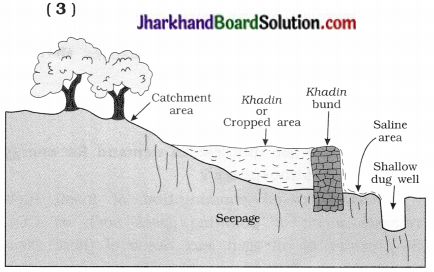
Questions :
- Which system is shown in given diagram?
- In which state and for what such system is adapted?
- State some name of the ancient water harvesting techniques.
Answer:
- Khadin system
- In Rajasthan state and to harvest the water such system is adapted.
- Kulhs, bundhis, bandharas, nadis, tanks and kattas.
Objective Questions and Answers
Question 1.
Answer the following questions in short:
(1) What are five R’s used to save environment?
Answer:
The five R’s to save environment are: Refuse, Reduce, Reuse, Repurpose and Recycle.
(2) Name the main constituents of coal and petroleum.
Answer:
Carbon, hydrogen, nitrogen, sulphur are the main constituents of coal and petroleum.
(3) How does mining cause pollution?
Answer:
Mining causes pollution because of the large amount of discarded slag when a ton of metal extracted.
(4) Why are forests called as biodiversity hot spots?
Answer:
Forests are called biodiversity hot spots because range of different life forms, i.e., bacteria, fungi, ferns, flowering plants, insects, birds, reptiles nematodes, etc. are all found in the forests.
(5) State two objectives of sustainable / development.
Answer:
Objectives of sustainable development:
- To provide the economic well being.
- To maintain healthy environment for future generations.
![]()
(6) State two disadvantags of monoculture.
Answer:
Disadvantages of monoculture :
- Large amount of biodiversity is destroyed in the area.
- The varied needs of local people can no longer be met from such monoculture.
(7) Which are the trees planted for monoculture?
Answer:
Pine, teak or eucalyptus, etc. trees are planted for monoculture.
(8) What is the purpose of water harvesting?
Answer:
Purpose of water harvesting is : To collect rainwater, allow it to percolate and thereby increase the ground water level.
(9) Make a list of few industries that are dependent on forest products.
Answer:
Paper, timber, bidi, lac and sport equipment industries.
(10) How the increase in demand for energy is affecting atmosphere?
Answer:
Increased consumption of fossil fuels releases a lot of polluting gases such as CO2, SO2i oxides of nitrogen, etc. Some of there gases cause global warming causing climate change and also produce acid rain.
(11) Mention the name of two dams whose construction faced opposition.
Answer:
Two dams whose construction faced opposition are :
- Tehri Dam on the river Ganga.
- Sardar Sarovar Dam on the river Narmada.
(12) Why are coal and petroleum called fossil fuels?
Answer:
Coal and petroleum are called fossil fuels because they have been formed millions of years ago inside the earth from buried vegetation due to high temperature and pressure.
(13) Name a greenhouse gas. What happens when its amount increases in the atmosphere?
Answer:
CO2, The amount of CO2 increases in the atmosphere will lead to global warming and climate change.
(14) The person lived near a forest. Make a list of four items which he can get from the forest to meet his daily needs.
Answer:
Fire wood, fodder, fruits, vegetables, medicines.
(15) If you find coliform bacteria in a water sample collected from river, what does it indicate? What is the cause of such kind of pollution?
Answer:
It indicates the contamination of water by disease causing microorganisms. Discharge of untreated sewage in water body is the main cause for such kind of pollution.
(16) Why is reuse better than recycling of materials?
Answer:
Reuse of materials is better than recycling because –
- Energy is not depleted in reusing the same matter.
- It reduces the stress on environment and helps in conservation of natural resources.
(17) State two reasons for launching the Ganga Action Plan.
Answer:
Ganga Action Plan was launched to improve the quality of water and remove the disease causing coliform bacteria present in the water of Ganga.
Question 2.
Define : OR Explain the terms :
(1) Natural resources
Answer:
Refer to the point 1 in the ‘Gist of the Chapter.
[or Substances which are obtained from nature and used by all living forms to sustain their life are called natural resources.]
(2) Sustainable management
Answer:
The controlled use of a resource in such a way that its present availability and continuous flow to the future generation is ensured without any disturbance to the environment is called sustainable management.
(3) Dams
Answer:
The barriers constructed across rivers to hold the water for different uses is called dams.
(4) Water harvesting
Answer:
A method of holding rainwater on the surface, to make it percolate under the ground to recharge ground water is called water harvesting.
(5) Biodiversity
Answer:
The number and range of variety of species of life forms in an area is called biodiversity.
(6) Fossil fuels
Answer:
The remains of plants and animals which are burried under the earth some millions of year ago and changed into fuel due to tremendous heat and pressure are called fossil fuels.
Question 3.
Fill in the blanks :
- Reuse is considered better than recycling because …………….. is utilised in the process of recycling.
- Increase in amount of …………….. leads to green-house effects ultimately leading to global warming.
- …………….. community in Rajasthan has been a religious tenet for conservation of forest and wildlife.
- Wildlife is an important component of the …………….. of an ecosystem.
- …………….. leaves are use to make bidies.
- …………….. forest of West Bengal is dominated by Sal trees.
- Forests are …………….. hot spots.
- Chipko Andolan originated from a …………….. village in Garhwal.
- The …………….. canal has brought greenery to considerable areas of Rajasthan.
- The loss of biodiversity may lead to loss of …………….. stability.
- The …………….. of water can easily be checked using universal indicator.
- Coliform is a group of bacteria found in human ……………..
- By processing on wastes of used product, new materials can be produced this process is known as ……………..
Answer:
- energy
- CO2
- Bishnoi
- food web
- Tendu
- Arabari
- biodiversity
- Reni
- Indira Gandhi
- ecological
- pH
- intestine
- recycling
![]()
Question 4.
State whether the following statements are true or false:
- Forests are the natural habitat for wildlife.
- The people live in or around forest are the stakeholders of forest for conservation.
- Mining causes pollution because of the large amount of fog discarded in environment.
- The wildlife and nature enthusiasts want to conserve nature in its pristine form.
- Monoculture enhances a large amount of biodiversity in a wide area.
- Amrita Devi Bishnoi sacrificed her life along with 363 others for the protection of khejri trees.
- Chipko Andolan was basically for saving Sal forest in Midnapore districts.
- Narmada Bachao Andolan is for protesting against the height of the Sardar Sarovar Dam on the river Narmada.
- We should not bother about our natural resources because there is plenty of natural availability.
- The major drawback of watershed management is to cause ecological imbalance.
- Coal and petroleum were formed from the degradation of biomass about millions of years ago.
- If combustion of fossil fuels takes place in insufficient oxigen, then carbon dioxide is formed instead of carbon monoxide.
Answer:
- True
- True
- False
- True
- False
- True
- False
- True
- False
- False
- True
- False
Question 5.
Graph – Diagram based questions:
1.

Identify a and b in given diagram.
Answer:
a – Khadin area
b – Saline area
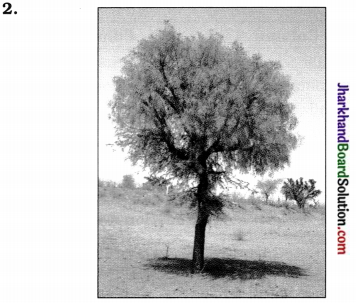
Identify and state the location where it is native species.
Answer:
Khejri tree, Khejrali village near Jodhpur in Rajasthan.
Question 6.
Match the following :
Answer:
(1)
| Column I | Column II |
| 1. Indicate minimization use of natural resources | p. Recycle |
| 2. New materials can be produced from industrial wastes | q. Reuse |
| 3. Always considered better method without being use of energy | r. Reduce |
| 4. No use of plastic bag | s. Refuse |
Answer:
(1 – r). (2 – p), (3 – q), (4 – s).
(2)
| Column I | Column II |
| 1. Forest Department | p. Want to conserve nature |
| 2. The industrialists | q. Controls the resources from forests |
| 3. Nature enthusiasts | r. Dependent on forest produce for their life. |
| 4. Tribal people | s. Use raw materials from forests. |
Answer:
(1 – q), (2 – s), (3 – p), (4 – r).
(3)
| Column I | Column II |
| 1. Bishnoi community | p. Recovery of Sal forest |
| 2. Himalayan National Park | q. Hug the Tree Movement |
| 3. Reni village in Garhwal | r. Alpine meadow |
| 4. A. K. Banerjee | s. Khejrali village |
Answer:
(1 – s), (2 – r), (3 – q), (4 – p).
(4)
| Column I | Column II |
| 1. Kerala | p. Kattas |
| 2. Karnataka | q. Surangams |
| 3. Tamil Nadu | r. Ahars and pynes |
| 4. Bihar | s. Eris |
Answer:
(1 – q), (2 – p), (3 – s), (4 – r).
Question 7.
Select the correct alternative from those given below each question:
1. Which village became famous due to Amrita Devi Bishnoi?
A. Reni
B. Khejrali
C. Midnapore
D. Arabari
Answer:
B. Khejrali
2. Forest based industries are _______.
A. meat and leather
B. coal and iron
C. petroleum and wood
D. timber, lac and paper
Answer:
D. timber, lac and paper
3. Which leaves are used in manufacture of bidies?
A. Tendu
B. Eucalyptus
C. Banyan
D. Khakharo
Answer:
A. Tendu
4. Find incorrect statement.
A. Forests provide varieties of products.
B. Forests have wide-variety of biodiversity.
C. Forests are not important in soil conservation.
D. Forests are helpful to maintain atmospheric CO2 concentration.
Answer:
C. Forests are not important in soil conservation.
5. Which of the following dam is constructed in Gujarat?
A. Tehri dam
B. Sardar Sarovar dam
C. Tawa dam
D. Bhakhara dam
Answer:
B. Sardar Sarovar dam
6. Which one of following is not a natural resource?
A. Land
B. Water
C. Electricity
D. Air
Answer:
C. Electricity
7. The most rapidly dwindling natural resource in the world is
A. water
B. forests
C. wind
D. sunlight
Answer:
B. forests
![]()
8. Which of the following option indicates the correct explanation for natural resources?
A. Sources can be created by man and utilized by man.
B. Sources can be created by man and utilized by all organisms.
C. Products obtained only from forests.
D. The naturally occurring, cannot be created by man and useful for all organisms.
Answer:
D. The naturally occurring, cannot be created by man and useful for all organisms.
9. Which are three R’s from five to save the environment?
A. Recycle, Regenerate, Reuse
B. Reduce, Regenerate, Redistribute
C. Reduce, Reuse, Redistribute
D. Reduce, Recycle, Reuse
Answer:
D. Reduce, Recycle, Reuse
10. Which option is not included in recycling to save environment?
A. Plastics, glass and metal waste should be properly separated.
B. Solid wastes melted at appropriate temperature and filtred it.
C. Use of appliances operated with solar energy to reduce the use of LPG.
D. New materials can be produced from wastes.
Answer:
C. Use of appliances operated with solar energy to reduce the use of LPG.
11. The method of reuse is always considered better than the recycling method because…
A. energy is not utilised in it.
B. new materials can be produced by it.
C. uniform distribution of natural resources can be done by it.
D. material or equipment can be maintained for a long time by it.
Answer:
A. energy is not utilised in it.
12. A successful forest conservation strategy should involve…
A. protection of animals at the highest trophic level.
B. protection of only consumers.
C. to stop all the products available from forests.
D. comprehensive programme to protect all the physical and biological components.
Answer:
D. comprehensive programme to protect all the physical and biological components.
13. ‘Chipko Andolan (Hug the Trees Movement) is the well-known example of conservation of which form of nature?
A. Forest
B. Coal
C. Water
D. Petroleum
Answer:
A. Forest
14. Which type of natural resource are forests and wildlife?
A. Biotic and renewable
B. Biotic and non-renewable
C. Abiotic and renewable
D. Abiotic and non-renewable
Answer:
A. Biotic and renewable
15. Which of the following is not a fossil fuel?
A. Petroleum
B. Natural gas
C. Mineral coal
D. Wood
Answer:
D. Wood
16. Which one is responsible for increasing demand of natural resource?
A. Environmental pollution
B. Increase in human population
C. Use of non-biodegradable materials
D. Loss of forest cover
Answer:
B. Increase in human population
17. Which option is correct for the work of forest department?
A. Distribute the forest products among the people who live in or around forests.
B. Control the resources from forests of government ownership.
C. Supplies raw materials to industrialists for their industry.
D. Protects rights of nature enthusiasts to conserve nature.
Answer:
B. Control the resources from forests of government ownership.
18. Which of the following activity is not helpful for the protection of environment?
A. Social forestry
B. Rotation of crops
C. Recycling of used water
D. Deforestation
Answer:
D. Deforestation
19. Amrita Devi had sacrificed her life for the protection of _______ trees.
A. khejri
B. banyan
C. pipal
D. pandanas
Answer:
A. khejri
20. For which of the following Amrita Devi Bishnoi National Award is given?
A. To prevent prenatal abortion
B. Wildlife conservation
C. Increase the use of non-conventional energy sources
D. Social forestry
Answer:
B. Wildlife conservation
21. Which of the following are related to Rajasthan?
A. Indira Gandhi canal
B. Khadins, tanks and nadis
C. Khejri tree
D. All of the given
Answer:
D. All of the given
22. One boy goes to a school by his vehicle. On the way he reaches to a cross-road where red signal is shown. He turns off his vehicle till green signal appears. From this, he has used which R to save the environment?
A. Reduce
B. Recycle
C. Reuse
D. None of the given
Answer:
A. Reduce
![]()
23. With increase in population, our needs have increased. Today the world is facing a problem of energy crisis. We must conserve energy. Which one of the following statement does not show energy conservation approach?
A. Make use of pressure cooker.
B. Switch off the lights, fans, television and other appliances when not in use.
C. One should use individual vehicle instead of public transport system.
D. Use of bicycle while going to school.
Answer:
C. One should use individual vehicle instead of public transport system.
24. Pick up correct statement for the concept of biodiversity.
A. It refers to the different species of plants and animals in the area.
B. It refers to only the plants of a given area.
C. It is greater in forest.
D. It refers to the total of individuals of human population in given area.
Answer:
A. It refers to the different species of plants and animals in the area.
25. Statement A: Water harvesting is an age-old concept in India.
Reason R: It is useful to recharge the ground water but not to hold surface water.
Which is correct option for statement A and reason R?
A. Both A and R are correct and R is correct explanation of A.
B. Both A and R are correct but R is not the correct explanation of A.
C. A is correct and R is incorrect.
D. A is incorrect and R is correct.
Answer:
C. A is correct and R is incorrect.
26. It is important to make small check dams across the flooded gullies because they…
A. hold water for irrigation.
B. hold water and prevent soil erosion.
C. recharge ground water.
D. hold water permanently.
Answer:
A. hold water for irrigation.
27. What are coliforms?
A. a group of bacteria found in human intestine.
B. a group of bacteria found in animal dung.
C. a group of bacteria found in root nodules of lagumes.
D. None of these
Answer:
A. a group of bacteria found in human intestine.
28. Statement A: Huge areas of forest are cleared for the plantation of pine, teak or eucalyptus.
Reason R: Monoculture plantation are useful for industries to access specific products and are an important source of revenue for the Forest Department.
Which is correct option for statement A and reason R?
A. Both A and R are correct and R is correct explanation of A.
B. Both A and R are correct but R is not the correct explanation of A.
C. A is correct and R is incorrect.
D. A is incorrect and R is correct.
Answer:
A. Both A and R are correct and R is correct explanation of A.
29. Find correct statements for the concept of sustainable development.
A. Growth that is acceptable to all stakeholders.
B. Stopping all developmental work to conserve the environment.
C. Growth irrespective of the extent of damage caused to the environment.
D. Planned growth with minimum damage to the environment.
Answer:
A. Growth that is acceptable to all stakeholders. Planned growth with minimum damage to the environment.
30. Who is known as India’s waterman?
A. A. K. Banerjee
B. Dr Rajendra Singh
C. Dr A. K. Singh
D. None of these
Answer:
B. Dr Rajendra Singh
Question 8.
Answer as directed : (Miscellaneous)
(1) Give full form of CPCB, MPN
Answer:
CPCB – Central Pollution Control Board MPN – Most Probable Number
(2) State the unit of coliform count levels in the water.
Answer:
MPN/100 mL
( 3 ) Find mismatched pair :
(i) Plastic carry bags – Refuse
(ii) Repair leaky taps – Reduce
(iii) Stored pulses in empty bottle of jam – Recycle
(iv) Cracked crockery use as feeding vessels for birds – Repurpose
Answer:
(iii) Pulses stored in empty bottle of jam – Recycle
(4) The desired minimum total coliform count level in the river Ganga are …
Answer:
500 MPN / 100 mL
(5) Who am I? One type of grass that grow within the reserved area of the great Himalayan National park.
Answer:
Alpine meadows
(6) Madhya Pradesh : Bundhis :: Himachal Pradesh: ………………
Answer:
Kulhs
(7) Find mismatched pair :
(i) Karnataka – Kattas
(ii) Tamil Nadu – Eris
(iii) Bihar – Surangams
(iv) Maharashtra – Bandharas
Answer:
(iii) Bihar – Surangams
(8) Identify me : I was degraded forest in south-western districts of West Bengal once but remarkable recovered by the active participation of local community in the management.
Answer:
Sal forest
Value Based Questions With Answers
Question 1.
Municipal corporation insists people to dispose wet wastes in green coloured dustbin and dry wastes in blue coloured dustbin for their domestic waste disposal. Municipal waste collection van collects domestic wastes only if wet and dry wastes are separated.
Questions:
- How this system is a good practice to reduce environmental pollution?
- What does generally wet waste contains?
- What is the productive use of wet wastes?
- What is use of dry wastes? Which concept do you think from five R’s?
Answer:
- It helps in segregation of biodegradable and non-biodegradable waste. These wastes are then properly treated for disposal. So, this system is good practice to reduce environmental pollution.
- Wet wastes contain food items, vegetable wastes, pills of fruits, etc.
- Wet wastes are used to produce fuel gas and manure.
- Plastic, broken glass, metal, etc. from dry wastes are used in recycle process to synthesise fresh plastic, glass, metal. We think about recycling concept from five R’s.
Question 2.
A group of college students shared their phone number on social media. They insist the people to donate their used clothes, books, toys, utensils, etc. They collect such used items and distribute to the needy.
‘Robinhood’ is a well-known name at national level. Members of this group collect the food that is left in restaurants and at the occasion of marriage and distribute to needy.
Questions:
- How many and which R’s come into play in this initiative?
- What objectives are fulfilled by this initiave?
- Is this environment-friendly practice?
Answer:
- Two out of five R’s i.e., Reduce and Reuse come into play in this initiative.
- Social responsibility, awareness about environment and reduction of the wastage of food, etc. are fulfilled by this initiative.
- Yes, this is an environment-friendly practice.
Question 3.
At present we encounter the problem of water shortage, as rainfall is less than average in past three years. Chairman of your society informed the members to reduce the water consumption. He also suggested to make percoting well in the society.
Questions:
- What are the benefits of percoting well?
- How can you store rainwater in any alternative way that protects the water against contamination?
- What value does the chairman of society have?
Answer:
- The benefits of percoting well are : it recharges the underground water, it does not allow the evaporation, it is protected from contamination.
- In close tank and underground tank.
- The chairman shows responsibility to environment, especially save the water and store the water.
Practical Skill Based Questions With Answers
The water samples collected from four different water bodies. I – from the river of Sabarmati, II-from the Kankaria Lake, III-from Chandola lake and IV-from Narmada canal.
| Water Sample | Coliform count level | PH |
| I | 12,000 MPN/ 100 ml | 7.8 |
| II | 7,900 MPN/100 ml | 6.7 |
| III | > 106 MPN / 100 ml | < 5.6 |
| IV | 1000 MPN/100 ml | 7.3 |
Questions:
- How do coliform enter in water body?
- Can we use water from any such water body? Why?
- What measures are required before using the water?
- How is the pH of water sample tested?
Answer:
- Coliform bacteria enter through disposal of untreated sewage in water body.
- No, because it is not safe for drinking.
- Boil the water well, filter it and then use it for drinking.
- The pH of water sample can be tested with universal indicator or with litmus paper.
Memory Map:
